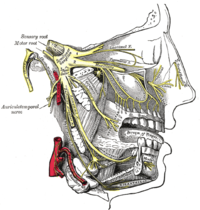
Photo from wikipedia
Life on earth undergoes daily and seasonal rhythms of the solar cycle, and organisms have evolved behaviors and functions that respond to these predicted light-dark cycles. For most species, this… Click to show full abstract
Life on earth undergoes daily and seasonal rhythms of the solar cycle, and organisms have evolved behaviors and functions that respond to these predicted light-dark cycles. For most species, this is driven by a ∼24-hour rhythmic expression of a set of core clock genes/proteins, which can be entrained by extrinsic cues (also called zeitgebers), such as light and temperature.1 The clock proteins, in turn, regulate large networks of gene transcription to control circadian aspects of behavior (e.g., the sleep-wake cycle and feeding) and physiology (body temperature, blood pressure, hormone levels, and metabolism, etc). The mammalian clock is synchronized by the central pacemaker, the suprachiasmatic nucleus, of the hypothalamus. Integrating zeitgeber signals with neuroendocrine functions, the hypothalamus is essential for maintenance of homeostasis in the body.
Journal Title: Neurology
Year Published: 2023
Link to full text (if available)
Share on Social Media: Sign Up to like & get
recommendations!